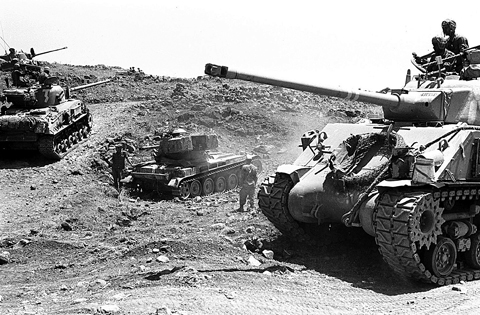 This file photo dated June 10, 1967 shows Israeli tanks advancing through difficult hilly terrain on the Golan heights during the Six-Day Arab-Israeli war. —AFP
This file photo dated June 10, 1967 shows Israeli tanks advancing through difficult hilly terrain on the Golan heights during the Six-Day Arab-Israeli war. —AFPJERUSALEM: The Arab-Israeli war of June 1967, or Six-Day War, radically changed the map of the Middle East. Between June 5 and 10, Israel defeated Egypt, Jordan and Syria and occupied Egypt's Sinai Peninsula, the Gaza Strip, the West Bank, east Jerusalem, and Syria's Golan Heights. Although Israel has since withdrawn from Sinai and the Gaza Strip, the Golan Heights and east Jerusalem have been annexed and the West Bank remains occupied by the Jewish state.
The conflict was preceded by several weeks of mounting tensions. Israel vowed on May 10 at the United Nations not to stand by when faced with incursions from Syria. On May 16 Egyptian president Gamal Abdel Nasser demanded that UN peacekeepers in the Sinai withdraw from Israel's border. He then blocked the Gulf of Aqaba to Israeli shipping, cutting off the Israeli port of Eilat. On May 30, King Hussein of Jordan signed a mutual defense pact in Cairo with Nasser. Here is a day-by-day account of the war:
Egypt's air power destroyed
At dawn on Monday, June 5, Israel stages an air assault that destroys more than 90 percent of Egypt's air force on the tarmac. Its armored vehicles head for Egypt. Arab countries declare war with Israel and Jerusalem comes under mortar fire.
Gaza falls
On Tuesday, June 6, the Israeli army seizes Gaza, which at the time is under Egyptian administration, pushing forward into the Sinai Peninsula. Israeli troops enter Jerusalem's Arab zone. After lengthy discussions between the United States and the Soviet Union, the UN Security Council unanimously adopts a resolution calling for an immediate ceasefire.
Israeli forces enter east Jerusalem
On Wednesday, June 7, armored vehicles clash in the heart of the Sinai, as the Israeli army occupies the east bank of the Suez Canal. Its navy seizes Sharm el-Sheikh and clears the Gulf of Aqaba for Israeli ships. "Most of the Egyptian army is fleeing in disarray and we have occupied most of the Sinai," Israel's army chief, General Yitzhak Rabin, later to become premier, tells a news conference in Tel Aviv.
Jewish neighborhoods in Jerusalem are bombarded. Israeli forces enter Jerusalem's Old City and Prime Minister Levi Eshkol visits the Western Wall. Israeli forces take most of the West Bank of the Jordan River, including the towns of Bethlehem and Jericho. "We have achieved our political and security objectives," Israeli Defense Minister General Moshe Dayan says. Jordan accepts the ceasefire.
Egypt capitulates
On Thursday, June 8, the Israelis reach the Suez Canal, signalling the end of the battle for Sinai. Overnight, Egyptian radio says Cairo is accepting the UN ceasefire. The White House says the hotline directly linking the US president and the Kremlin has been used several times during the crisis. Artillery fire continues at the Israeli-Syrian border.
Nasser steps down
On Friday, June 9 Israel launches an assault on the fortified Golan Heights, capturing it from Syrian forces after a day of heavy fighting. Towards 6:00 pm Nasser announces on television that he is stepping down from the Egyptian presidency, causing consternation in the Arab world. He does a temporary U-turn three hours later when citizens go into the streets and ask him to stay. Israel accepts the ceasefire.
Syria ceases fighting
On Saturday, June 10, fighting rages on the Syrian-Israeli front. Israel brings its whole military arsenal into play to wipe out Syria's fortified positions. After the fall of the town of Kuneitra, Syria, which had already accepted the ceasefire, gives in and ceases fighting. The war is at an end and the Arab world is in a state of shock. In six days, Israel has broken the pan-Arab myth of Nasser, destroyed three Arab armies which threatened its existence and set the borders at the Suez Canal, the River Jordan and the Golan Heights. - AFP










